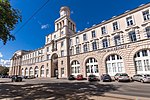Petrogradskaya (Saint Petersburg Metro)

Petrogradskaya (Russian: Петрогра́дская) is a station on the Moskovsko-Petrogradskaya Line of the Saint Petersburg Metro. The station was opened on July 1, 1963. The name was given by its location on Petrograskaya Storona and Petrogradskiy district The ground vestibule is by architects Andreev and Moskalenko, and is in the building of "Dom mod" ("House of Fashions"), at the intersection of Kamennoostrovsky prospect and Big prospect of Petrogradskaya Storona, near Leon Tolstoy square. There is underground slope to a pedestrian subway (originally with escalators, dismantled later). Petrogradskaya is station of deep location with platform screen doors. Its depth is 53 metres (174 ft). Underground hall was designed by architects Belov, Govorkovsky, Rivin, Tregubov and Shimakovsky. Crimped surface of the walls is tiled with ceramics. Rear wall is decorated with panel against the blue grating background with profiles of worker and kolkhoz woman, which expose the theme of revolutionary Petrograd. According to the most recent version of the system expansion plan, Petrogratskaya will become a transfer station, connected to the future Koltsevaya Line. From January 5, 2013, till November 2013, the station was closed for capital repair.
Excerpt from the Wikipedia article Petrogradskaya (Saint Petersburg Metro) (License: CC BY-SA 3.0, Authors, Images).Petrogradskaya (Saint Petersburg Metro)
Kamennoostrovskiy Avenue, Saint Petersburg Petrograd Side (округ Аптекарский остров)
Geographical coordinates (GPS) Address Nearby Places Show on map
Geographical coordinates (GPS)
| Latitude | Longitude |
|---|---|
| N 59.966388888889 ° | E 30.311388888889 ° |
Address
Kamennoostrovskiy Avenue 37
197022 Saint Petersburg, Petrograd Side (округ Аптекарский остров)
Saint Petersburg, Russia
Open on Google Maps











